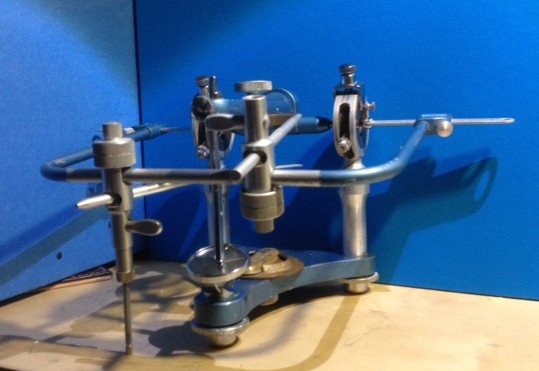The Dentatus Anatomical Articulator with the incorporated Dentatus Facebow.

The above machine is used to record with accuracy the relationship during function of the movement of the upper and lower jaws.This is essential if balance is maintained during static and movement. If accomplished successfully will produce a comfortable set of dentures.
This equipment will ultimately reduce any number of problems listed below.
This machine is able to record the individual angles of movments on both left and right hand side of the face. These lower jaw controlling joints are found in front of the ears. The movements of each joint are individual to all people and need to be carefully set and recorded so that the resulting denture teeth during grinding are running smoothly over each other. Just like a wheels in a machine.
This machine then imitates the movement of a clock pendulum swinging from side to side.
There are a number of adjustable controls on this machine plus the variations in back tooth cuspal angulation which allow confortable chewing.
This machine is very successful in helping to combat uncomfortable denture comfort in cases of arthritis of the joints and enables the Clinical Dental Technician to re establish the correct positions when they have been lost due to tooth wear due to poor quality teeth or excessive use of comercial cleaners( see cleaning management).
Denture Problems can arise from a number of symptoms. Listed below are a selected few which may be the reason of any number of causes and freqently are not readily rectified by simple denture modifications but are design errors performed in the initial manufacturing process.
1 Lower rides up when at rest.
2 Lower denture feels as if it is hovering in my mouth when eating and talking.
3 Lower denture comes up at the front when eating or talking
4 Lower denture comes up at the back when eating and talking
5 Lower denture comes up on the opposite side when I am eating on the left or right side.
6 Lower denture makes my lower lip stick out and/or makes my lower muscles ache after continuous use.
7 Lower denture gives me pain when eating resulting in ulcers.
8 I feel my lower denture is making my chin come closer to my nose giving me a squashed face appearance.
Upper Denture Problems
1 Keeps dropping down when eating or talking.
2 Have to use adhesive to keep the denture up
3 Have to keep taking my denture out as it makes my face ache. It feels as if it is streching my lips.
4 Cant use my tongue to move the food from the outside of the denture in my cheeks
5 Seem to show a lot of upper teeth
a at rest
b when smiling
c when talking
d when laughing.
6 Have started to lisp when speaking and find it difficult to pronounce certain words
7 My lips dont come together which makes it difficult and uncomfortable to swallow.
If you experience any of the above conditions then contact me for a up to date diagnosis and prognosis.
The Dentatus Facebow
Is a critically important piece of equipment and should be standard when all dentures are being constructed.
The Dentatus facebow is not just a success on account of its ease of handling as it makes possible, rapid cranium / lower jaw axis relationship corresponding to the patient‘s anatomy, In both rest and during function. Enabling the successful diagnosis and treatment speedily possible. Patient’s dentures very frequently undergo extensive alterations at the fit stage with the new dentures being excessively ground or in some cases being returned to the laboratory for alteration and remake.
This becomes a tedious undertaking for both patient and operator in both time and money at the chairside.
The Dentatus Facebow is therefore a 3D method of relating the upper jaw to the controlling joints by the ears. This Cranium/axis relation ultimately determines the corresponding path of tooth movement in a smooth and harmonious pendulum like movement. From a patients point of view the lower denture readily feels tighter during the chewing movements.